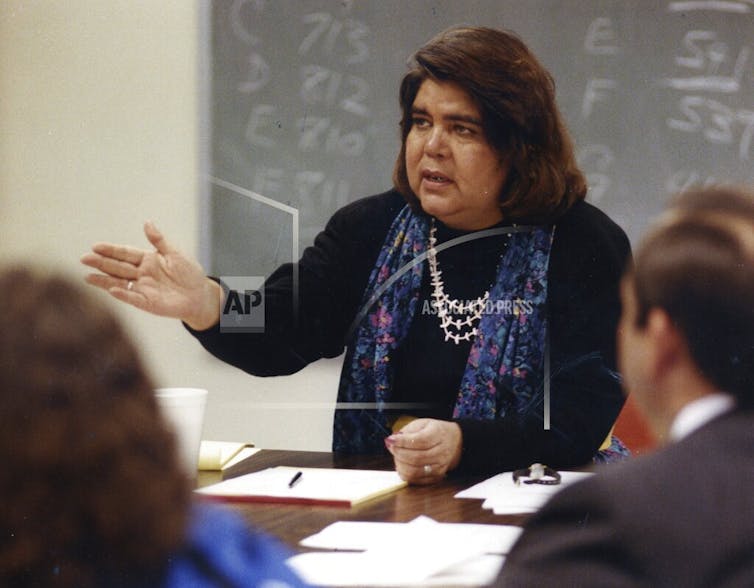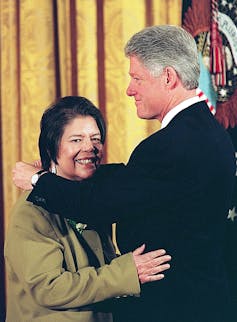Your Cart is Empty
✈️Free Shipping Over $99 USD

Mankiller’s life resembled many Native people’s lives in the 20th century before she assumed the role of principal chief of the Cherokee Nation in 1985.
She was born in Tahlequah, Oklahoma, at an Indian hospital in 1945. She grew up on land secured by Cherokee people over three generations of shifting U.S. federal Indian policies, each with devastating results: the Treaty of New Echota in 1835, the Treaty of 1866 and the Curtis Act in 1898.
Mankiller’s family relocated to San Francisco in the 1950s after Congress passed the termination and relocation policy, seeking to break up and relocate Native American tribes to assimilate them. In San Francisco she met Indigenous people from diverse communities.
Mankiller’s duties as chief included attending the Arkansas Riverbed Authority meetings to discuss multiple Native communities’ access to water. Tom Gilbert/Tulsa World via AP Images
She came of age in San Francisco during the Red Power Movement, which was marked by Indigenous people’s activism across the country and aimed to draw attention to broken treaty promises, widespread dispossession and police brutality. She and her siblings supported the occupation of Alcatraz, a takeover by Native activists that lasted 18 months.
She married young, had children and willed herself through a college education. She divorced and returned home to Oklahoma in 1976 as a single parent with two daughters. Mankiller’s family history, like that of so many Native Americans in this country, cannot be told or understood without understanding changes in federal Indian policy, which often dictated where Native people lived and the economic opportunities available to them.
Mankiller’s life was similar to those of many families who remained in Oklahoma on allotments or within Cherokee communities after Oklahoma became a state in 1907. Until the age of 11, she grew up in Adair County, which was about 46% Cherokee in the 2020 census.
When she returned to Oklahoma from California in the late 1970s to work for the Cherokee Nation, she prioritized and supported a community-driven project that brought running water to the Bell community. Bell, a rural community in Adair County, is still home to large pockets of Cherokee people. This effort was later dramatized in the 2013 film “The Cherokee Word for Water.” Mankiller’s commitment to improving the lives of Cherokee people was central to her work, even before she became chief.
Her rise to the position of principal chief in 1985 coincided with a moment when the efforts of civil rights activists, Black nationalists, Red Power and women’s rights activists of the previous decades were bearing fruit. She represented and modeled what people like Gloria Steinem, with whom Mankiller formed an enduring friendship, hoped to see more people achieve in the larger U.S.
A tall white man with thick gray hair places medal around neck of shorter woman with cropped brown hair
Mankiller’s impact extended beyond Cherokee people. In a nod to her accomplishments, President Bill Clinton awarded her the Presidential Medal of Freedom in 1998. Mankiller understood that she represented how far women leaders had come and the hope we might still arrive where we need to be.

President Clinton awards Wilma Mankiller the Presidential Medal of Freedom. Paul J. Richards/AFP via Getty Images
I still remember learning of her death from pancreatic cancer in April 2010 when I was a graduate student in history at the University of North Carolina at Chapel Hill, not far from Salem College where she first inspired me. I, like many others I imagine, wept for her, enormously proud of all she had achieved.
Mankiller’s transition to chief wasn’t easy. People initially questioned a woman’s ability to lead the tribe. If there was any doubt of Mankiller’s capabilities as a leader when she took over as chief in 1985, in her second election to office six years later, she received almost 83% of the vote.
She gained support by exemplifying gadugi – a Cherokee word that means working together collectively for the benefit of the whole community. She drew upon her culture, history and tribal identity as a leader, and she raised her daughters Gina and Felicia Olaya to do the same. Though neither held office, both have worked for and supported the Cherokee Nation throughout their lives.
During her time as chief, Mankiller provided a foundation for the continued growth of the Cherokee Nation. Enrollment in Cherokee Nation doubled under her leadership. She championed education and secured a US$9 million vocational center. A 1991 Parade Magazine profile described her leadership style as quiet but strong.
At her mother’s memorial, Gina, who died in October 2022, said that her mother taught her family “how to laugh, how to dance, to appreciate Motown music, to be a humble servant to our people, to love one another unequivocally and to cherish each and every moment we spent together as a family.”
Mankiller articulated what generations of Cherokee people knew – that Indigenous people are capable of generating the solutions to the problems they face. As chief, she focused on issues that benefited some of the most vulnerable Cherokee people, such as rural development, housing, employment and education. Mankiller listened to community members to determine the way forward. I believe her legacy, now enshrined on a quarter, will continue to inspire new generations of people seeking to make a difference in the world.
I watched a documentary on Wilma, (with an unforgettable name) Also read her history. An outstanding Hero! A SUPER HERO! She proved her worth in office..
This is an outstanding read! Thank You for the love you have showed toward the life of one of the Greatest Native Leaders!!
Comments will be approved before showing up.
Pam Piscitelli
November 06, 2024
Thank you for your post. She is truly an inspiration all. I will have to search for the documentary mentioned above.